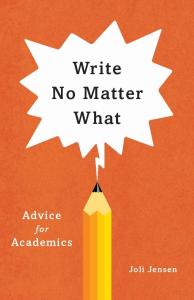 Joli Jensen is the Hazel Rogers Professor of Media Studies at the University of Tulsa, where she founded and directs the Henneke Faculty Writing Program. Her new book is Write No Matter What: Advice for Academics (University of Chicago Press, 2017).
Joli Jensen is the Hazel Rogers Professor of Media Studies at the University of Tulsa, where she founded and directs the Henneke Faculty Writing Program. Her new book is Write No Matter What: Advice for Academics (University of Chicago Press, 2017).
CMOS: What sets your book apart from other writing advice books?
JJ: Write No Matter What is designed to help faculty and graduate students deal with obstacles that keep us from writing. It focuses on how to recognize and overcome the particular combination of factors that keeps us from wanting to write, or from enjoying writing when we finally get to it. It’s about actually doing the writing, not about how to write in an academically appropriate style or how to get published.
 CMOS: That’s an issue familiar to all kinds of writers, not just academics, wouldn’t you say?
CMOS: That’s an issue familiar to all kinds of writers, not just academics, wouldn’t you say?
JJ: Absolutely. Academic life has its own particular challenges (like constant evaluation, teaching and service demands, and tenure requirements), but all writers can benefit from the insights and productivity techniques I offer.
CMOS: You write about various “taming techniques” for moving forward in one’s writing, such as committing to fifteen minutes of writing a day. Why so little time?
JJ: Advice on how to be a prolific writer can be summarized in one sentence: we need brief, frequent, low-stress, high-reward contact with a project we enjoy. Sadly, academic life offers us the exact opposite: long, infrequent, high-stress, low-reward contact with projects we come to dread.
So the main benefit of committing to fifteen minutes a day, no matter what, is that we stay in frequent, low-stress contact with our project. We don’t give drama and dread a chance to overtake us, and so the project stays “write-sized.” Once we do our fifteen minutes, we can go about the rest of our day without guilt and anxiety. It’s quite liberating, and usually the fifteen minutes leads to longer writing sessions.
CMOS: Describe the “ventilation file” you recommend. Do you see that as a temporary crutch or a lifelong tool?
JJ: The ventilation file has been a lifelong tool for me. Writing, no matter how much we like our project or use various productivity techniques, can trigger all kinds of emotional baggage. Having a safe place to write about the frustration, fear, hatred, doubt, and misery you are feeling about your project works like a magic bullet. Acknowledging—rather than suppressing or talking yourself out of—whatever project-related feelings are coming up helps them dissipate. The colleagues I advise in our Faculty Writing Program at the University of Tulsa know that they can spend their daily fifteen minutes “ventilating,” and they usually reconnect and find a way forward in the next few days.
CMOS: In your book you describe keeping a “project box” that’s a physical collection of files in an actual box. Do you have feedback from users who have chosen to make online project files and boxes instead? Does that work just as well?
JJ: I’m loyal to the visual, tactile, old-school file box because I like to outline my ideas on paper, and I use hard copy for final copyediting. But any way that you “tame” your project is fine. The project box—physical or online—is a way to keep a writing project organized, inviting, and most important, separate from distractions. The project box is any contained writing space that can be opened and closed. Suggestions for online project boxes include creating a separate login so that on your screen you only have access to project-related files, and then using one of the services that blocks access to online distractions.

JJ: “This is the inviting, organized writing space
I finally created, after years of failed attempts.”
CMOS: What is “following the lilt”? Describe the benefits.
JJ: Years ago I realized to my surprise that students, when given a chance to do an independent project, pick something they don’t really want to do. My faculty colleagues often do exactly the same thing—picking, designing, or getting stuck in writing they don’t really want to do. So as an advisor, I learned to listen for a characteristic shift in someone’s voice—a lighter, more energetic tone that appears when they are talking through their ideas, or chapter, or plans. This helps me identify what truly interests them in their writing project. In faculty writing groups, we “follow the lilt” to help each other commit to writing only about what we care about. Lack of lilt suggests that we are off track—doing a project we don’t really want to do, or doing it in a way that doesn’t work for us. Following the lilt helps us keep working on writing projects we truly enjoy.
~ ~ ~
Joli Jensen’s other books include Is Art Good For Us? Beliefs about High Culture in American Life; The Nashville Sound: Authenticity and Commercialization in Country Music; and Redeeming Modernity: Contradictions in Media Criticism. Find her online at www.jolijensen.com.
Please see our commenting policy.



